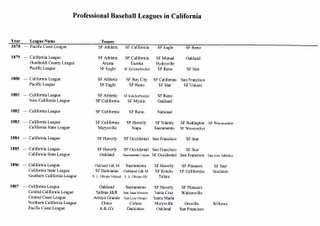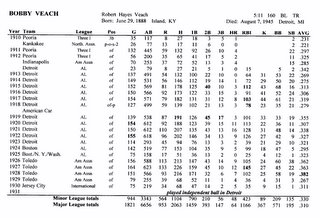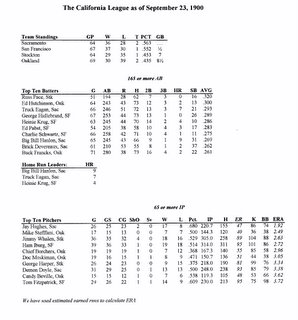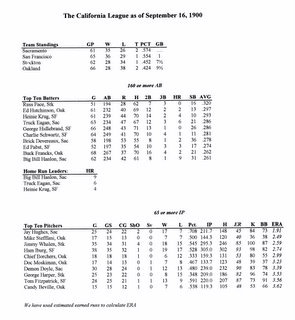Happy New Year!
Happy New Year!
Carlos
This blog is dedicated to the minor league baseball research community, and will serve that community with news, research tips, and promote minor league baseball historical research. email: minorleagueresearcher@yahoo.com


The season of 1884 represented the beginning of the first golden age of
After the multiple box-office failures of 1883, the 1884 season took almost forever to get started, with bats finally being crossed on July 27. The league concluded its season with all clubs crossing the finishing line on November 23. (An October rainout was rescheduled for November 27, after the season closed, but never came off.)
The 1884 season consisted of ten Sunday contests, and the California League would remain a Sunday-only affair until 1888, when the population centers would support more baseball. It also marked the first appearance of the great Haverly [Theater] team, and the first great California-bred pitcher, Billy Incell, who went 8-0 for the Haverlys, and led the league with 107 strikeouts.
For the first time ever, the same clubs came back for an encore season in the California League in 1885. The league got an early start (on February 1), but could only make through the May 24 games of a schedule that envisioned finishing in up in late November.
I don’t know if the cause of the collapse was anyway related to the completion it received by the California State League, which began play on May 10, but it could not have helped. The State League itself folded in within a few weeks (June 7), it could boast a first for professional baseball in
Fred McKinzie
1885
1886 SF
1887
Tomorrow I will continue with the 1886 season, a season in which the state had both the
Note: I noticed a couple of omissions in the league chart that I published yesterday, which I had entered into my book by hand but had not typed into the chart itself, so I will correct it here in this post.
Click on Image to Enlarge League Chart

I stumbled across this note in the “Caught on the Fly” column:
“One year of sandlot ball was enough for veteran Bobby Veach, who played the outfield in the majors for many years. Veach was a member of a
Note: Prior to the Second World War, many, many players continued their careers after finishing with Organized Baseball. Often they would make more in independent leagues, industrial leagues, and independent teams. The independent would pay these players much more than a minor league club could or would offer. Black Sox players did that, Buck Weaver played in the Chicago City League up into the 1930s, while Cicotte pitched in the
If there is anybody out there with access to
The above career record is from The Historical Register, published by Baseball Press Books. Used, obviously, with permission.
Click on Image to Enlarge


As Reviewed by Bob McConnell
Bob McConnell wrote this review of my book some time ago, and submitted it to the Minor League Committee, by the chair, for some reason, chose not to publish it, so I am posting it here with a sample page.
The Early Coast League Statistical Record, 1903—1957
by Carlos Bauer
310 pages, published by Baseball Press Books,
As the title of the book indicates, it covers statistics of the Pacific Coast League from 1903 thru 1957. The complexion of the league changed in 1958 due to the invasion of the major leagues into the
The main feature of the book consists of year-by-year stats as follows:
A. League standings with club managers and Win-Loss records
B. Batting stats (Position, G, AB, R, H, 2B, 3B, BR, RBI, SO, BB, SB, Avg) by club. Only pitchers with 100+ AR are included. RBI, SO and RB not included for early years.
C. Pitching stats (G, GS, CG, ShO, Sv, W, L, Pct, IP, H, R, ER, SO, BB, ERA) by club. ER and ERA are calculated for the early years, using a method explained in the introduction.
D. Batting stats for players with two or more clubs.
E. Pitching stats for pitchers with two or more clubs.
F. Listing of all managers.
Standings for several seasons have been revised from those published originally in guides as a result of extensive research.
Stats are included for LESS THAN players whose stats were not included in the averages published in the guides.
Additional features:
A. Introduction by Chuck Stevens who played in the PCL for many years.
B. Introduction by Roger Osenbaugh who pitched in the PCL for many years.
C. Introduction by author detailing his methodology of compiling the statistics contained in the book.
D. Year-by-year list of league presidents and secretaries.
E. League playoff results.
F. Year-by-year league leaders in all batting and pitching categories.
G. Evolution of league batting and pitching records (player who established record in 1903 and each player who established new record thru the years)
H. Year-by-year club attendance starting with the 1919 season. Table includes the names of the ballparks each year.

This Week in the
This week, the San Francisco Wasps edged to within ½ game of the leaders, in one of the tightest pennant races ever in the California League. The fall scheduling— with no game in the interior on Saturday— and two doubleheaders on Sunday.
On Saturday, the Gilt Edge club came to
On Sunday,
In the afternoon tilt,
At
Back across the bay,
Of note, the San Francisco Examiner stated that Truck Egan’s seventh home run of the season— hit in the second inning— was only the second ball ever hit over the left-field fence at
To get a better view of the Standings & Leaders, click on image.


This Week in the
Games this week were played on Monday, September 10, Tuesday, September 11, and on Saturday and Sunday, September 15 and 16.
Because Admission Day fell on a Sunday, games were played on Monday in
In
At
On Tuesday,
Over at
There was only one game on Saturday, at
On Sunday at
In the afternoon contest, the Dudes pitched Borchers again, but he gave up 5 runs in the first, and the game was ostensibly over right then. Tom Fitzpatrick also pitched for the third time that week, and managed to hang onto the 9-6 win. Both Rube Levy and Heinie Krug led the Wasp attack with 3 hits apiece. And while Borchers didn’t do much on the mound, he did get 3 hits for the losers.
At
In the afternoon tilt,
To get a better view of the Standings & Leaders, click on image.

From The Sporting News, January 19, 1928:
More on PCL Salaries:
Walter (Dutch) Ruether, veteran southpaw pitcher, recently cut adrift by the New York Yankees, has refused to sign with the San Francisco Seals of the Pacific Coast League, even though he was offered [a] $5,000 bonus to put his name on a contract, says a report from the Golden Gate city. [I]n addition to the bait, Ruether was offered a contract for $5,000 by the Seals officials. This was agreeable, but the veteran wanted more to sign his name to the document. He left the matter open, and is waiting to see if the initial offer will not be swelled a bit.
Note: I don’t know what he eventually signed, but apparently Ruether was happy with the outcome of negotiation, because he did in fact sign with the Seals, and went on to have a 29-7 season, his best ever in the Coast League. This is just another instance of how the Coast League took care of its players.